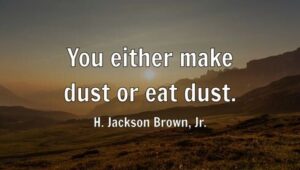《自律養生實踐家之旅377》 塵埃的神蹟

人一生中,除了爭取生存的權利,便是在旅途中不斷體悟這趟旅程的目的與意義。必須要有目的,因為終將抵達終點;也必須要有意義,否則就不必前來。
出生百年後仍活著,會被稱為人瑞;若已離去,則只剩一堆骨骸,或一堆塵土。
生命的旅途總會遭遇那些不可思議的發生,初時讚嘆,隨後適應,最終將不可思議視為理所當然。
放牛班的同學考上第一志願,令人稱奇;升學班的第一名榜上無名,令人錯愕。
這是我印象中最粗淺的「不可思議」,最初令人驚嘆,後來成為生命中的常態。
研究科學的人,將眼睛看得見的歸為「實證」,看不見的,則稱為「神蹟」。大自然中確有一種平衡之力,我們看不見,卻常被其威力震懾。
那麼,大自然的力量中有神蹟嗎?抑或,大自然本身就是一場神蹟?許多問題的表面充滿疑惑,而疑惑之中往往隱藏著無從挑戰的真相。
當科學走入瓶頸,能解釋的就剩下法則,無論是法則還是神蹟,都同樣是人類不可侵犯的界線。
還記得大一那場艱難的化學實驗考試,我必須透過觀察溶液顏色變化來判斷其中的化學元素。如今早已忘記自己如何過關,只記得那是我最不喜歡的學科之一。
那張熟悉的化學週期表,對化學家而言,每個元素都有精確的原子量與性質;
但在我眼中,那只是一堆塵土。
然而,就是這些無機的元素構築了有機生命的複雜組合。在基因的指令下,化學元素成為形體、生機與樣貌,那正是我所讚嘆的「不可思議」。
單細胞與多細胞共生,動物與植物共生,高等與低等生命共生,而有機與無機、生命與塵土也共生。
近年來,研究腦意識成為科學的新領域。人類開始探索同理心、正念與意識的奧秘,這些依附於「生命跳動」的元素,一旦生命停止,便連塵土都不是。
人類從未離開哲學的疆界,也未曾忽視佛學的啟示。透過閱讀,我感受到科學家對靈性世界的敬畏,那是你我熟悉卻早已疏離的空間,不是擁有人身的我們可以輕談的內容。
與自己的身體充分互動後,我常在「生命跳動」的殿堂前駐足,那是我思考的聚焦。心臟的跳動並非關鍵生命的起源,大腦意識也不是,有學者指出關鍵在粒線體,也有學者堅持為腸道微生物發聲。而我,在身體的引導下,領悟了大自然不可侵犯的力量。
還記得英國探險家喬治・瑪洛里那句名言「它就在那兒」嗎?他所指的,是聖母峰;我所詮釋的,則是大自然的平衡法則。
那股神奇的平衡力,在我們身上,就是長久被輕忽的「療癒力」。
每當我書寫「造物主的創意」,腦中浮現的總是「進化的力量」。此時,仍執著於科學思維的人,終將被現實三振出局;而信任造物主的人,則能以瑪洛里的那句「它就在那兒」作答。
回到人生的意義,柯維提醒我:「要留下典範」,我與自己對話的結論是:「要留下紀錄」,紀錄必須能被傳承,也必須對他人有助益。
我們見證過太多被病痛摧毀的典範人生,一場病,能摧毀所有努力;倒下後,再也爬不起來。
於是領悟到:在追尋意義的路上,仍需保有健康的「生命跳動」。
這就是法則的呼喚,身體始終在提醒我們。身體能做到的,我們沒有理由、也沒有權力剝奪。
那不正是那股「不可思議的神奇療癒力」嗎?
停下腳步,好好審視自己所處的環境。我們是否沒有聚焦於身體的療癒力,反而過度依賴醫療體系的治療力?
試問:我們對自己的存在感到合理嗎?滿意嗎?感覺身體在退化,還是願意給身體機會更進化?
若渴望健康、渴望圓滿,就該順應那股神奇的療癒力,正面看待造物主所賦予的神蹟,而非讓身體充滿人類意識的想像與操弄。
是神蹟組合了塵土,是神蹟讓塵土成為有形的軀體,是神蹟以愛注入塵土,演繹成動人的生命章節。
有學者以《土療(Eat Dirt)》為題出版著作,作者提醒家長:孩子真正需要的健康元素,就在泥土之中。
我們可以嗤之以鼻,但不該忘記,泥土並非骯髒之物,而是神蹟所賦予的生命之源。
我們皆為塵,也皆自土而生。我們共享神蹟的恩典,必然得遵行自然的法則。願我們都能尊重並珍惜身體內,那份大自然所內建的神蹟。
(你不是製造塵土,就是吃塵土。)
The Miracle of Dust
In a lifetime, beyond the struggle for the right to survive, we spend our journey continually realizing its purpose and meaning.
There must be a purpose—because the journey inevitably ends.
There must be meaning—otherwise, there would be no reason to come at all.
A century after birth, if one still lives, they are called a centenarian;
if not, they remain only bones—or dust.
Along the road of life, we encounter countless moments of the “incredible.”
At first, we marvel; then, we adapt; and eventually, we come to accept the incredible as ordinary.
When a poor-performing student gets into the top school, we call it amazing;
when the star pupil fails to make the list, we find it unbelievable.
That was my earliest, most naïve understanding of the “incredible”—
what once astonished me gradually became a pattern of life.
Those who study science classify what can be seen as “evidence,”
and what cannot be seen as “miracle.”
Yet there truly exists in nature a force of balance—
invisible, but awe-inspiring in its power.
Does that mean there are miracles within nature’s forces?
Or is nature itself one grand miracle?
Many questions appear filled with doubt,
but within doubt often lies a truth that cannot be challenged.
When science reaches its limits, what remains explainable are merely laws.
And whether it is law or miracle, both mark boundaries humanity cannot cross.
—
I still remember that grueling chemistry lab exam in my freshman year,
when I had to identify chemical elements by the changing color of a solution.
I’ve long forgotten how I passed—only that chemistry was among my least favorite subjects.
That familiar periodic table: to chemists, each element bears a precise atomic weight and property;
to me, it looked like nothing more than a chart of dust.
Yet it is precisely these inorganic elements that form the complex architecture of organic life.
Under the command of genes, the elements give rise to form, vitality, and appearance—
and that, to me, is the most profound “incredible.”
Single-celled and multicellular life coexist;
animals and plants coexist;
higher and lower life forms coexist.
Even the organic and the inorganic—life and dust—coexist.
In recent years, the study of consciousness has become a new frontier of science.
Humanity now seeks to explore empathy, mindfulness, and awareness—
those subtle dimensions sustained by the “pulse of life.”
Yet once life ceases, even dust is no longer what it was.
Humanity has never strayed far from the borders of philosophy,
nor turned away from the insights of Buddhism.
Through reading, I have felt the reverence scientists hold for the spiritual realm—
a realm familiar yet estranged to us,
one that those still clothed in human flesh dare not speak of lightly.
—
After years of deep interaction with my own body,
I often find myself standing before the altar of “life’s rhythm.”
That is where my reflections converge.
The heartbeat is not the true origin of life, nor is consciousness.
Some scholars claim the key lies in the mitochondria;
others advocate for the voice of the gut microbiome.
As for me, guided by my own body,
I have come to understand the inviolable power of nature.
Do you recall the English explorer George Mallory’s famous words—
“Because it’s there”?
He spoke of Mount Everest;
I speak of the laws of balance in nature.
That mysterious force of equilibrium within us
is none other than what we have long neglected—the power to heal.
Whenever I write about “the Creator’s design,”
what comes to my mind is always “the power of evolution.”
Those who cling rigidly to scientific thinking will ultimately be struck out by reality,
while those who trust the Creator can simply echo Mallory’s words:
“It’s there.”
—
Returning to the meaning of life,
Stephen Covey once reminded us: “Leave a legacy.”
My own dialogue with myself concludes: “Leave a record.”
A record must be passable across generations—
and beneficial to others.
We have witnessed too many exemplary lives destroyed by illness.
One illness can wipe out a lifetime of effort;
once fallen, some never rise again.
Thus I realized: in the pursuit of meaning,
we must still preserve the living pulse of health.
This is the law calling to us—
the body constantly reminding us.
What the body can accomplish,
we have neither the reason nor the right to take away.
Isn’t that the very “incredible healing power” itself?
—
Pause for a moment,
and truly examine the environment you inhabit.
Have we lost focus on the body’s own healing power,
replacing it instead with dependence on medical intervention?
Ask yourself:
Do we feel justified in our own existence?
Are we content?
Do we sense our bodies declining,
or are we willing to give them the chance to evolve further?
If we yearn for health and wholeness,
we must align with that wondrous force of healing—
to see the miracle bestowed by the Creator with reverence,
not to fill our bodies with human projections and manipulation.
It is the miracle that assembled the dust.
It is the miracle that shaped the dust into form.
It is the miracle that infused dust with love,
weaving it into the living poetry of existence.
One scholar published a book titled Eat Dirt,
reminding parents that the essential elements of health for children
are found within the soil itself.
We may scoff at this,
but we should never forget—
soil is not filth,
but the source of life given by miracle itself.
We are all dust,
and from dust we were born.
We share in the grace of miracles,
and thus must live by nature’s laws.
May we all learn to honor and cherish
the miracle of nature that lives within our very bodies.


